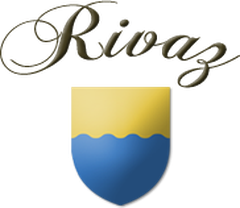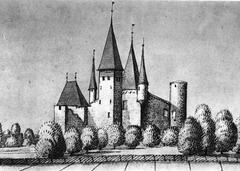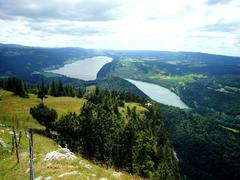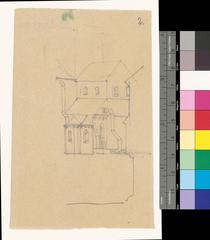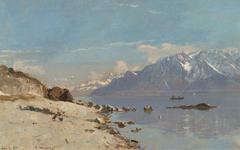Rivaz, Canton Vaud, Switzerland: Historical Sites, Visiting Hours, and Tickets Guide
Date: 14/06/2025
Introduction
Nestled on the sun-kissed northern shores of Lake Geneva, Rivaz is the smallest commune in the canton of Vaud and a gem within the Lavaux UNESCO World Heritage region. Famed for its breathtaking terraced vineyards—painstakingly crafted since the Middle Ages—Rivaz is a living testament to the harmonious interplay of history, culture, and renowned Swiss viticulture. This comprehensive guide equips travelers with essential information about Rivaz’s historical significance, administrative framework, and vibrant wine culture. Whether you’re seeking practical details about visiting hours, ticketing, accessibility, or transportation, or looking to immerse yourself in centuries-old traditions, this guide will help you plan a memorable journey to one of Switzerland’s most cherished wine villages.
The roots of Rivaz stretch back to medieval times, when Benedictine and Cistercian monks pioneered the terracing and viticulture that still define the landscape (UNESCO). The region’s dry stone walls, iconic for their engineering and beauty, form a unique microclimate ideal for the Chasselas grape, the foundation of celebrated wines like Dézaley Grand Cru AOC. Generations of winegrowing families—such as the Chappuis, established in the 14th century—continue to uphold traditions and foster sustainability in this living cultural landscape (Lavaux Experience, The winegrowers of Rivaz).
Rivaz’s administrative autonomy within Switzerland’s federal system supports the preservation of its heritage and the promotion of sustainable tourism (Commune de Rivaz, Canton de Vaud). Visitors can explore medieval stone houses, atmospheric wine cellars, panoramic vineyard trails, and partake in local festivals—each experience enriched by the village’s deep-rooted sense of community and stewardship.
Contents
- Introduction
- Historical Context & Administrative Evolution
- Preservation of Heritage & Viticulture
- Visiting Rivaz: Hours, Tickets & Accessibility
- Top Attractions & Activities
- Events & Festivals
- Practical Tips & FAQs
- Visuals & Media
- Summary & Recommendations
- Sources & Further Reading
Historical Context & Administrative Evolution
Medieval Foundations and the Rise of Viticulture
Rivaz’s origins are entwined with the exploitation of its unique topography for viticulture. From the 11th century, Benedictine and Cistercian monks developed terracing techniques and grape cultivation methods, shaping not only the land but the very identity of the region (UNESCO). The village’s winding lanes and stone dwellings are a testament to this agricultural legacy, offering visitors a tangible connection to the past (Commune de Rivaz).
Integration into the Canton of Vaud
Once controlled by the Counts of Savoy and then the Bernese, Rivaz was integrated into the Canton of Vaud following the Helvetic Revolution in 1798. This transition established Rivaz as an independent commune and solidified the administrative boundaries that continue to protect its autonomy and traditions (Canton de Vaud).
Local Governance and Community Engagement
Rivaz operates under Switzerland’s commune system, granting significant autonomy in civil affairs, land management, and public services (Commune de Rivaz). The General Council, with approximately forty members, meets biannually to deliberate on local issues. The commune is part of the Lavaux-Oron district, which fosters cooperation with neighboring villages and cantonal authorities.
Preservation of Heritage & Viticulture
Conservation of the Landscape
Lavaux’s inclusion as a UNESCO World Heritage Site in 2007 underscores the global significance of its cultural landscape (UNESCO). Strict preservation guidelines protect the terraced vineyards and historic architecture, ensuring that Rivaz remains an authentic window into centuries of winegrowing tradition.
Winegrowing Families and Living Heritage
Viticulture dominates 70% of Rivaz’s land, with fifteen winegrowing families—such as the Chappuis—upholding intergenerational traditions (The winegrowers of Rivaz). These families play a central role in maintaining the terraces and producing the region’s signature Chasselas grape wines. Wine tourism, including tastings and holiday accommodations, supports local sustainability and offers visitors a direct link to the village’s living heritage.
Visiting Rivaz: Hours, Tickets & Accessibility
Administrative and Tourism Office Hours
- Administrative Offices: Open Monday–Friday, 8:30 AM–11:30 AM and 2:00 PM–5:00 PM. Assistance outside these times is available via Chexbres (Commune de Rivaz).
Wine Cellars, Tastings & Tours
- Domaine Christophe Chappuis: Open Monday–Saturday, 10:00 AM–6:00 PM. Advance booking for tours and tastings is recommended. Tours typically cost CHF 20–50 (Lavaux Experience).
- Lavaux Vinorama: Daily 10:00 AM–6:00 PM. Admission is free; tickets for tastings and guided tours are available onsite or online.
Lavaux Vineyard Terraces
- The terraces are open year-round and free to explore. Guided tours operate daily (April–October), generally from 9:00 AM–6:00 PM, with tickets around CHF 40–60 including tastings (myswitzerland.com).
Accessibility
Rivaz is accessible by train (Lausanne, Vevey, Montreux connections), car (limited parking), and boat (CGN cruises). Many trails and visitor centers are accessible for those with mobility challenges, though some steep areas may require assistance.
Top Attractions & Activities
- Vineyard Walks: Well-marked trails connect Rivaz to Saint-Saphorin, Epesses, and beyond. Panoramic views of Lake Geneva and the Alps abound (The Discovery Nut).
- Wine Tastings: Numerous family-run wineries welcome guests for tastings and cellar tours. Advance reservations are recommended.
- Lavaux Vinorama: Features educational exhibits and tastings from over 150 producers.
- Village Temple: The medieval chapel (dating to 1439–1446) remains a focal point for community events (fr.wikipedia.org).
- Lake Activities: Enjoy boat cruises, swimming, and paddleboarding from the village’s lakeside port (April–October).
Events & Festivals
- Wine Festivals & Harvest Celebrations: Held annually in September and October.
- Caves Ouvertes (Open Cellar Days): Participating wineries open their doors for tastings and tours.
- Fête des Vignerons: A rare, once-in-a-generation festival in nearby Vevey. Annual local events keep traditions alive in between (Winetraveler).
Practical Tips & Frequently Asked Questions (FAQ)
Q: Are there entrance fees for visiting the vineyards or village?
A: The vineyards and trails are free to access. Wine tastings, guided tours, and special events usually require tickets.
Q: Do I need to book wine tastings or tours in advance?
A: Yes, especially during peak seasons. Reserve via official websites or the local tourist office.
Q: Is Rivaz accessible for visitors with disabilities?
A: Many areas are accessible, but some steep paths may be challenging. Contact providers for specific accommodations.
Q: What’s the best season to visit Rivaz?
A: Spring and autumn are ideal for mild weather, vibrant scenery, and wine events. Harvest season (September–October) is particularly lively.
Q: How do I reach Rivaz?
A: Trains run regularly from Lausanne, Vevey, and Montreux. Boat cruises operate April–October. Arriving by car is possible, but parking is limited.
Q: Can I bring pets?
A: Pets are generally allowed on public trails; check with wineries before visiting.
Visuals & Media
- Visit the official Rivaz website for galleries, maps, and virtual tours.
- Lavaux Experience and MySwitzerland offer interactive maps and downloadable guides (Lavaux Experience, myswitzerland.com).
- Enhance your visit by capturing sunrise or sunset views over the vineyard terraces and Lake Geneva.
Summary & Visitor Recommendations
Rivaz offers an authentic blend of history, culture, and world-class viticulture within the stunning framework of the Lavaux Vineyard Terraces (UNESCO). The village’s medieval charm, preserved architecture, and living wine traditions provide a truly immersive Swiss experience. Whether you’re a history enthusiast, wine lover, or scenic traveler, Rivaz promises rewarding discoveries and lasting memories.
To maximize your visit:
- Book wine tours and tastings in advance.
- Use public transport for convenience.
- Explore walking trails for panoramic views.
- Attend local festivals and support family-run wineries.
- Download the Audiala app for guided tours and current updates.
Sources and Further Reading
- Commune de Rivaz
- UNESCO World Heritage List – Lavaux, Switzerland
- The winegrowers of Rivaz
- Lavaux Experience
- Lavaux Wine Tasting and Terraces Guide – Winetraveler
- Lavaux Vineyard Terraces – MySwitzerland
- Canton de Vaud Official Website
- The Discovery Nut
- Wikipedia: Rivaz (Vaud)


